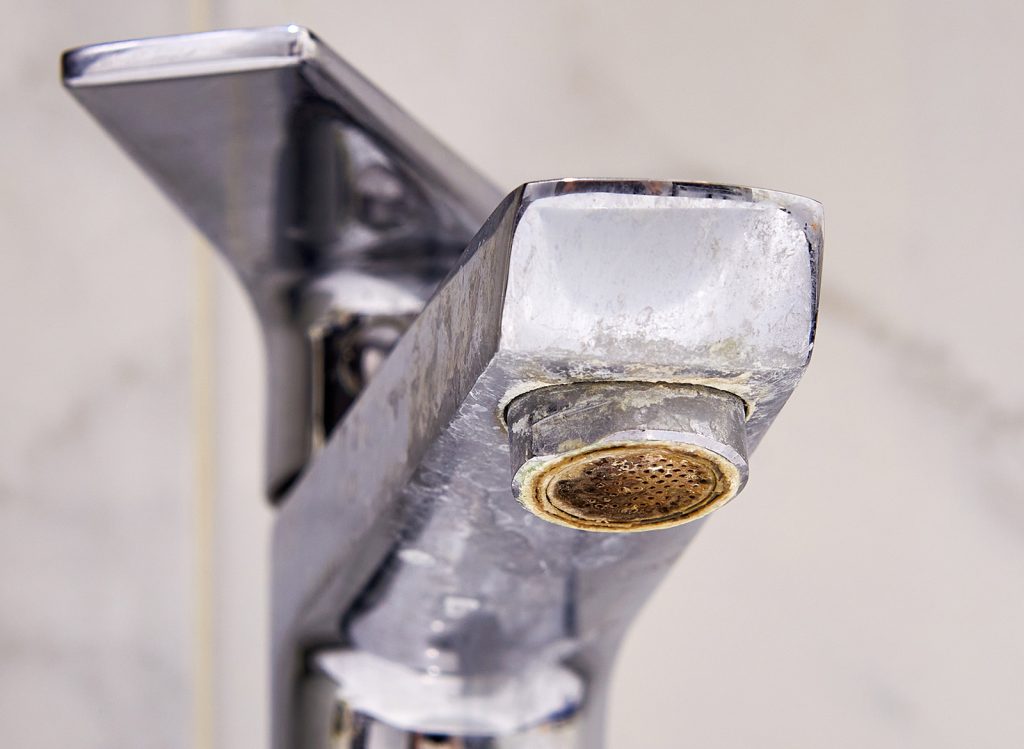
One of the most critical parameters for the success of an aqueous (water-based) cleaning solution is the pH of the solution. In the most rudimentary terms, pH is a measure of how acidic or basic a solution is. To understand pH in cleaning solutions, however, we need to understand pH in more technical terms. Scientifically speaking, pH is the negative log of the concentration of hydronium ions (H3O+), ranging from 0 to 14, with neutral at the mid-point of 7.
Water dissociates according to equation 1. The water dissociation constant, Kw, governs this dissociation according to equation 2, where the square brackets indicate concentration in moles per liter of hydronium and hydroxide (OH–) ions. The value of Kw for pure water is 1.0 x 10-14, thus when there are no impurities present, the concentration of hydronium ions is equal to the concentration of hydroxide ions, and both concentrations are 1.0 x 10-7. The negative log of this is 7, thus pure water has a pH of 7.
Similarly, many inorganic soil deposits react with acid but do not react with alkalinity, thus the common approach to dealing with inorganic soils is to use acidity and the products used on inorganic soils tend to be acidic. This includes products such as descalers/hard water deposit removers, toilet bowl cleaners and rust removers. So, what happens if our soil is organic, such as dietary fat? These materials are triacyl glycerols and contain ester groups which can be hydrolyzed under both acidic and alkaline conditions. Despite this, we typically use alkalinity to remove fatty soils, rather than acidity, because the products of ester hydrolysis are the fatty acid and the glycerol. Glycerol is readily water soluble and is easily rinsed from the surface being cleaned. However, the water solubility of the fatty acid is highly dependent upon pH. If the solution pH is below the fatty acid pKa, typically in the range of 4-5, the fatty acid will be protonated and relatively water insoluble. If the solution pH is above the fatty acid pKa the fatty acid will be deprotonated and relatively water soluble. Similarly, other organic soils can react with both alkalinity and acidity, but we prefer to use alkalinity due to the water solubility of the reaction products. Thus, products where the typical soil encountered is organic tend to be alkaline. This includes products such as oven cleaners, degreasers, all-purpose cleaners, and laundry detergents.
2 H2O H3O+ + OH– – (1) Kw = [H3O+] [OH–] – (2)
If we add an acid to pure water, the concentration of hydronium ions goes up, let us assume to 10-5, thus the pH would be 5. Similarly, if we add a base to pure water, the concentration of hydroxide ions goes up, again let us assume to 10-5, and thus the concentration of hydronium ions would go down to 10-9 (remember we must satisfy equation 2) and the pH would be 9. So, if we add an acid to water the pH goes down, and if we add a base to water the pH goes up. Obviously, the more acid or base we add to the solution the more the pH moves away from 7, and more reactive the solutions become. So, what happens when our aqueous cleaning solution encounters a soil like a calcium carbonate deposit caused by hard water? If our solution pH is basic (also called alkaline), there is no reaction between the soil and the solution. Hydroxide ion will not react with calcium carbonate. However, if our solution pH is acidic, there is an immediate reaction according to equations 3 and 4, and we can easily see the bubbling as carbon dioxide gas is formed.CaCO3 + 2 H3O+ Ca2+ + H2CO3 + 2 H2O – (3)
H2CO3 H2O + CO2(g) – (4)
Similarly, many inorganic soil deposits react with acid but do not react with alkalinity, thus the common approach to dealing with inorganic soils is to use acidity and the products used on inorganic soils tend to be acidic. This includes products such as descalers/hard water deposit removers, toilet bowl cleaners and rust removers. So, what happens if our soil is organic, such as dietary fat? These materials are triacyl glycerols and contain ester groups which can be hydrolyzed under both acidic and alkaline conditions. Despite this, we typically use alkalinity to remove fatty soils, rather than acidity, because the products of ester hydrolysis are the fatty acid and the glycerol. Glycerol is readily water soluble and is easily rinsed from the surface being cleaned. However, the water solubility of the fatty acid is highly dependent upon pH. If the solution pH is below the fatty acid pKa, typically in the range of 4-5, the fatty acid will be protonated and relatively water insoluble. If the solution pH is above the fatty acid pKa the fatty acid will be deprotonated and relatively water soluble. Similarly, other organic soils can react with both alkalinity and acidity, but we prefer to use alkalinity due to the water solubility of the reaction products. Thus, products where the typical soil encountered is organic tend to be alkaline. This includes products such as oven cleaners, degreasers, all-purpose cleaners, and laundry detergents.
